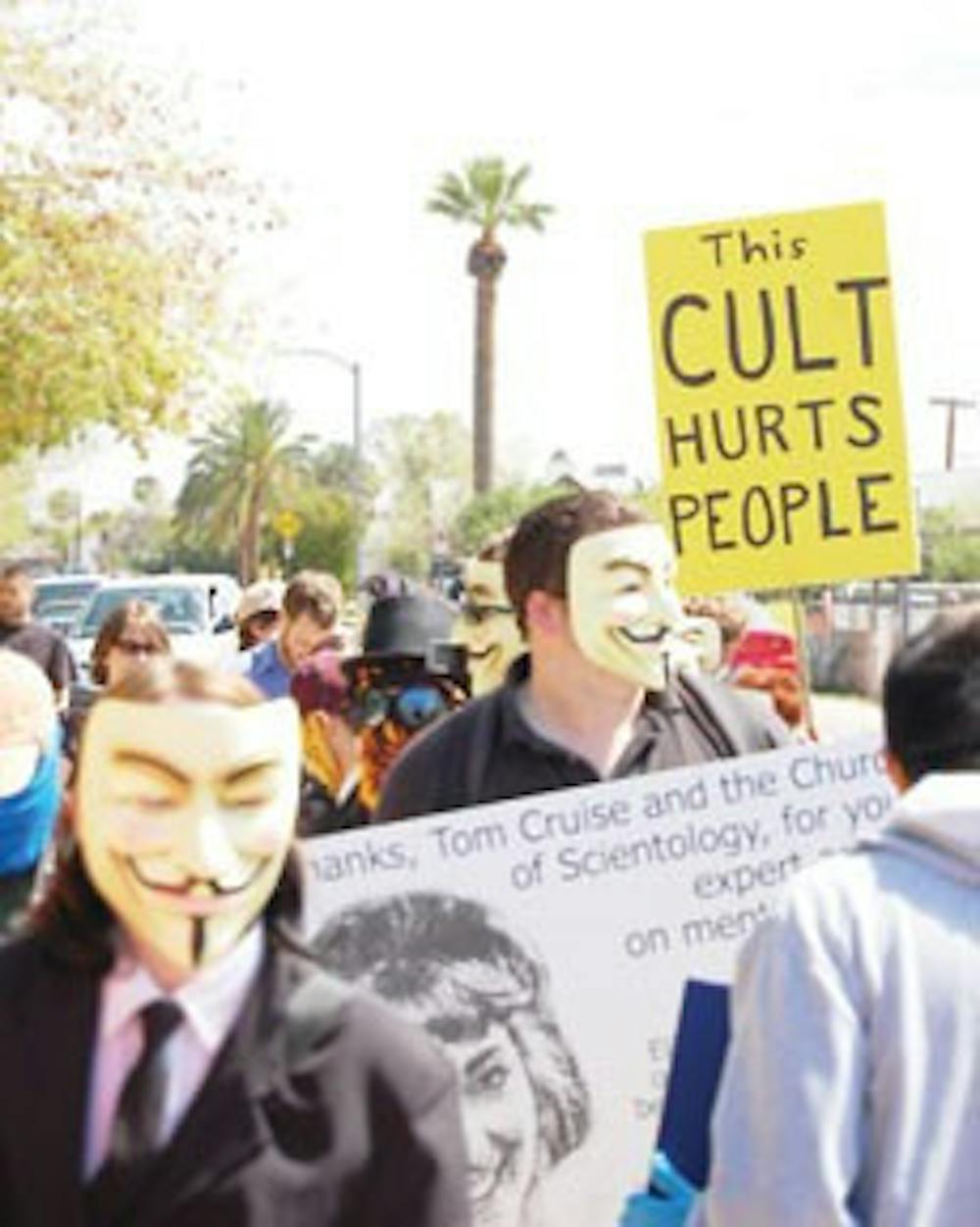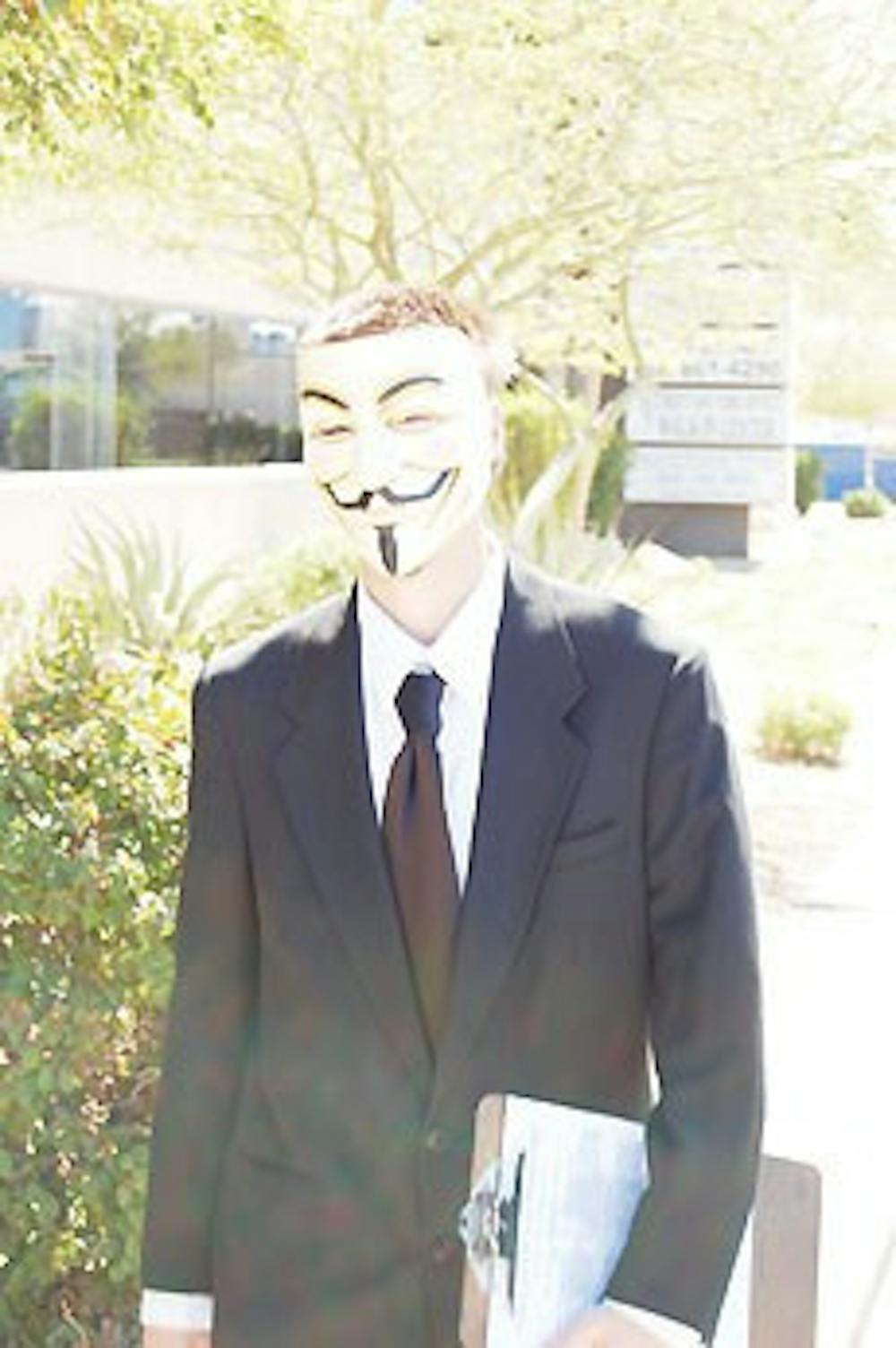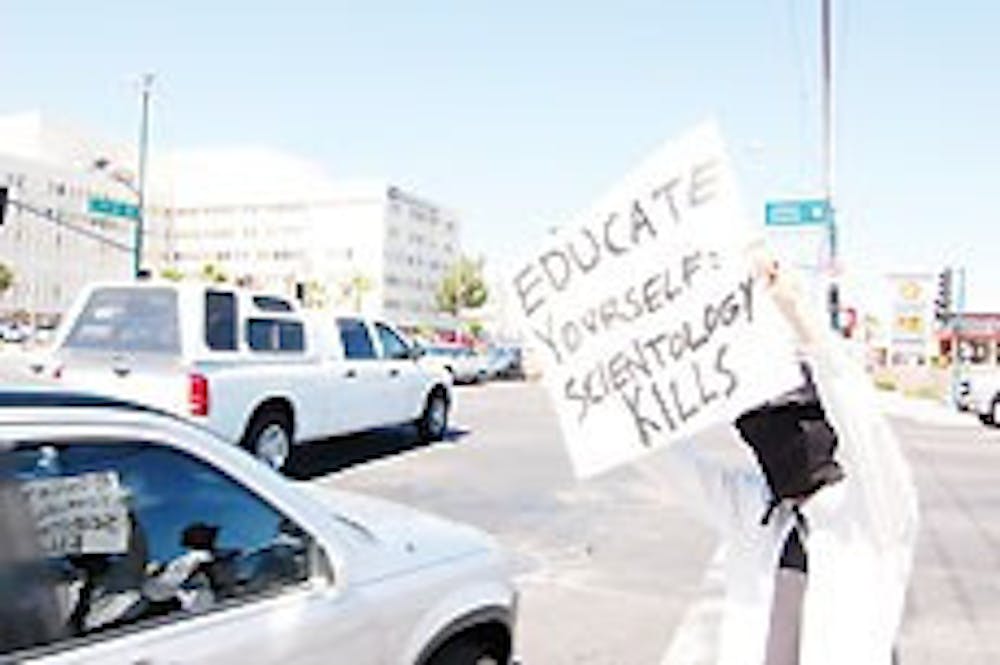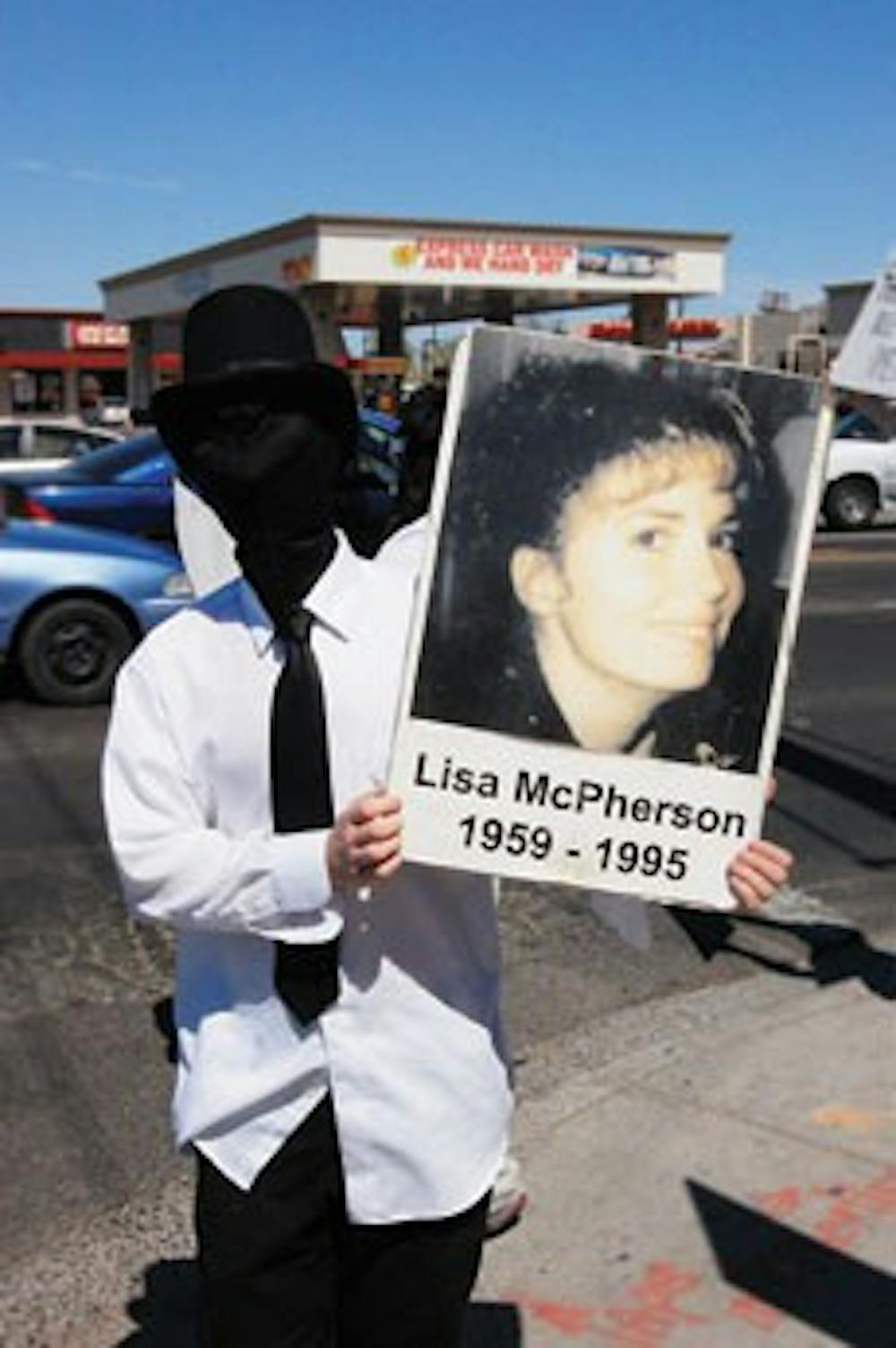Members of the Internet-hacker group Anonymous are masking themselves to take down what they see as a corrupt organization: the Church of Scientology. This week, SPM meets some of the faces under the masks and uncovers what they are fighting against.
It's an ominous scene reminiscent of the film "V for Vendetta." On the night of March 5, a handful of people approach each other cautiously, making sure not to blow their cover. They have plans to band together, but remain on their guard.
Introducing themselves only by their Internet aliases, the group collectively wears masks of famous British traitor Guy Fawkes, known to them as "Epic Fail Guy," or EFG, since Fawkes failed to blow up the British Parliament.
Passers-by give concerned and curious looks as a man in a black suit and tie comes storming around a corner with signs in hand, signs that reflect his attire. The group is about to start a "raid."
They tape the large sign with the outline of a black suit and tie facing inward on a window outside Coor computer commons. 3/15/08 is the date written on the sign. They post fliers surrounding it, each one stating their intentions.
"Why should we consider Scientology a threat? Because they don't pay taxes. Because they brainwash. Because they torture and murder their own followers. Because they infiltrated the FBI. Because they control large sums of money. Because they want to dominate the world. You wouldn't support Charles Manson's cult, so don't support L. Ron Hubbard's," the sign says. "Brought to you by Anonymous."
The group is a small, Phoenix-based portion of the world-renowned Internet group Anonymous, which made headlines when they declared war on the Church of Scientology in January.
Behind their mysterious name lies a complicated explanation of how the group came to be, and how they have cohesively rallied around a single cause — the dismantling of Scientology.
They call it Project Chanology.
Behind the mask
One thing Anonymous' members agree upon is that there's no clear definition of what Anonymous really is.
"It's a collective of different people from different walks of life that, for whatever reason, are uniting under a common cause, for laughs or for serious reasons," Evan Bryner says. He is the man in the black suit on that March 5 night, and a 22-year-old Anonymous member who has become a grassroots leader within the group.
Steven,* a 21-year-old ASU student and member who recently parted from Anonymous, described it as "organized chaos." He likened it to the online encyclopedia Wikipedia in its self-correcting ways.
Possibly the best way to defi ne Anonymous is through the Internet image boards 4chan and 711chan, which is a "catch-all for the Internet," Bryner says.
The site is essentially a community blog where anyone can post. It ensures complete anonymity of its users by only having them register a nickname and password. No names or e-mails are needed to register with the site. If a user does not register a nickname, the default option is "Anonymous."
When viewing the site, comments under the name "Anonymous" can be attributed to a single person or a collection of random users. In that way, Anonymous is no one and at the same time, everyone.
Anonymous decided to take Project Chanology from the Internet into the real world after a video of Tom Cruise, one of Scientology's most famous members, was posted on You Tube where he outlined his beliefs as a Scientologist. After Anonymous members noticed that the video had been promptly taken down at Scientology's request, the group became outraged.
The uprise gave birth to Project Chanology, a take-off of the word Scientology. Anonymous members in dozens of cities took to the streets to protest what they say is the religion's suppression of free speech.
But Anonymous' group organization became difficult because the group lacked internal structure and hierarchy.
"It's kind of a paradox in a way because we have no structure and yet there is some structure behind it," Bryner says of the Anonymous leaders who have risen
up within the group.
From the 'Internets' to 'IRL'
Although Bryner has played a part in the organization of Phoenix Anonymous, to pinpoint leaders of Project Chanology in each city worldwide is a nearly impossible task. Not only are Anonymous members reluctant to give their full names to each other and the press, but most members insist that they are part of the collective group.
Of course, there is someone hosting Anonymous' Project Chanology Web site and posting updates, but nobody knows quite who.
Until Project Chanology, Anonymous has had very few causes that they collectively rallied behind. "A lot of Anons will hack other people's MySpaces [and] a lot of Anons will start drama online," Bryner says. "But along the lines of real-life protests like this, there really hasn't been much."
For some members of Anonymous, Project Chanology has been the ultimate outlet for expressing how they really feel about Scientology.
21-year-old Anonymous member Tiffany Johnson has taken a leadership role during the group's protests at the Phoenix Church of Scientology.
"It's not the only cause I care about, but this is one that seems to have enough support that it's worth going after," Johnson says. "I mean, you can stand one person in front of any other cause, but it's not going to be as effective."
But Steven says the group is approaching protesting and other efforts in the wrong way. Steven agrees that something must be done to remove Scientology from its tax-exempt status, but he says that wearing EFG masks and being vague in fliers isn't the best way to go about it.
"[Anonymous and I] agree with the fact that the Church of Scientology is a dangerous organization," he says. "We agree that the public needs to be notified about the issues. What we don't agree on is how to get the message out there."
"The protests are a good idea, but with the masks we wear, no one will take us seriously," Steven says. "With the faces we put on, we're destined for failure. People are more likely to fear us than they are to understand us."
Crusaders or religious bigots?
Anonymous has cited many reasons for starting Project Chanology, including what they see as human-rights violations by the church and even just for the "lulz," or inappropriate laughs.
But for most members, the problem with the Church of Scientology initially started with a leaked video being posted on You Tube and other sites that profiled Tom Cruise, possibly Scientology's most famous member.
In it, Cruise speaks about his passion for the religion and his beliefs as a Scientologist. Though the source of the video is unclear, many speculate that the clips are from a church promotional video.
The video was taken off You Tube shortly after it was posted, which Anonymous attributes to copyright-litigation efforts by Scientologists against video-sharing sites.
However, an interview portion of the tape is still posted on Gawker.com. The site claims the video is newsworthy and refuses to take it down.
Cruise has been the center of media attention for the church and has often been the butt of jokes on television shows like South Park. Gawker.com and many other media critics claim that Cruise looks dazed when he speaks about Scientology, a religion he's been a prominent member of for 18 years.
"Being a Scientologist, you look at someone and you know absolutely you can help them," Cruise says in the video. "Being a Scientologist, when you drive past an accident, it's not like anyone else. As you drive past, you know you have to do something about it because you know you're the only one that can really help."
In the video, Cruise claims Scientologists are authorities in helping people.
"I enjoyed watching [the video]. It made me laugh a lot," Bryner says. "[Cruise] seems to force this dramatic persona — that he has this power through Scientology."
While continuing to battle Scientology, Bryner does not deny that Scientology can help people to a certain extent, though being the only person able to help in a car crash might be stretching it, he says.
"It seems legitimate in the beginning that they do help people, which I see nothing wrong with," Bryner says. "It seems like after that they really [use] science fiction [like], 'Well, you're really unhappy because alien souls have gotten inside your body.'"
Indeed, L. Ron Hubbard, a former science-fiction writer, founded the Church of Scientology in 1952, expanding on his book called "Dianetics." Scientologists regard "Dianetics" as a book of ideas and principles to live by.
Although The Church of Scientology declined to comment for this story, Joan Ryan, student director at the Phoenix branch, said that despite Anonymous' claims, the church does do good things. "Scientology helps improve people in any way that they need, Ryan says. "We can increase abilities, we handle drugs [and] educational problems."
Bryner insists his personal problem with Scientology is not with the Scientologists themselves, but with the thought that a follower of Scientology has to pay to learn more about the church doctrine and its stories, he says.
"If someone wants to be a Scientologist, I have no problem with that," Bryner says. "Freedom of religion is a guarantee in this country — as long as Scientology is seen as a religion. If there's one day that it's not, then they lose that freedom."
Losing the status of "religion" in the eyes of the IRS is Anonymous' ultimate goal in taking on Scientology. Currently, Scientology is recognized as a religion and a nonprofit organization, therefore the church does not have to pay taxes.
"Hopefully they lose their tax-exempt status [and] they realize that they can't keep doing what they have been doing in the past," Johnson says of her personal goals with Project Chanology.
"We have to be doing something right because they're afraid and they're retaliating and they're going on the offensive," she says.
The Ides of March
It's the morning of 3/15/08. The date on the signs has arrived. Anonymous calls it the Ides of March protest. The group will be marching outside Phoenix's Scientology building.
Dozens of Anonymous members and supporters meet at Steele Indian School Park in Phoenix, putting finishing touches on picket signs. As protestors put on their costumes and masks, Johnson stands on a bench and outlines what regulations protestors are expected to obey.
The protest must be peaceful. Picketers are urged to go nowhere alone, not to engage Scientologists and to be respectful.
The protest is to garner public support.
"Keep it Gandhi, people," she says.
And with that, they're off. Masked men and women march down Indian School Road, heading toward Seventh Street. The intersection is the home of the Phoenix Church of Scientology.
As a precaution, Anonymous called the police department ahead of time for protection in case any fights were to break out. Already aware that the protest is going to take place, Scientologists sit outside the building behind a gate, but do not respond to protestors.
Anonymous members spread along the sidewalk outside the business complex that the Phoenix Church of Scientology shares with numerous other companies. Traffic at the intersection starts to slow as protestors hold up signs with messages ranging from the serious, "Does your church have an investigative unit?" held by a man in a Guy Fawkes mask, to the blunt, "Fuck Scientology," held by a man in a penguin costume.
The signs "Honk if you hate Scientology" and "Honk if you think Scientology is a cult" make an already-busy intersection even noisier.
"Oh, did you hear that?" one protestor yells at the Scientologists sitting outside in response to the honks. "That's an L. Ron fart."
Anonymous hate crimes?
Declining to comment about the protest, Phoenix Scientologists issued a written statement and DVD to the press regarding their views about Anonymous and the threats that have allegedly been directed toward the church and its members.
"Since January 17, 2008, Anonymous, a group of cyberterrorists hiding their identities behind masks and computer anonymity, has targeted the Scientology religion, its churches, leaders and parishioners with hate speech and hate crimes," the statement says.
"The church has not interacted with these Anonymous individuals nor does it desire to. However, death threats and threats to plant nitroglycerin bombs in churches have madeit necessary to take security precautions and identify members of this group responsible for these crimes."
In the DVD, the makers clearly state that Anonymous is a hate group targeting the Church of Scientology. They claim Anonymous is responsible for or has encouraged 8,139 harassing phone calls, 3.6 million harassing e-mails, 10 acts of vandalism, 22 bomb threats and eight death threats worldwide, although none are attributed to any specific person.
Still, Anonymous claims the church is the bad guy in this war and is planning another protest for April 12, 2008.
"It's Operation Reconnect, and it's going to be more focused on reconnecting family members with other family members still in Scientology," Johnson says of the next protest. "Scientology has a disconnection policy that as soon as you leave, those who are in cannot talk to those who are out. I mean, you're completely cut off."
Mid-way through the Ides of March protest, Anonymous decides to gather outside the gate where Scientologists sit. Protestors proceed to sing Rick Astley's "Never Gonna Give You Up," after which they rap the "Fresh Prince of Bel-Air" theme song — a tribute to Will Smith, a friend of Tom Cruise, who they say is becoming a Scientologist.
The show is finished by a belated dedication of "Happy Birthday" to L. Ron Hubbard, Scientology's founder, who died in 1986.
The Scientologists do not respond, only watch.
Scientology 101
Often cast aside as a cult unworthy of religious status, Scientology has received
plenty of scrutiny from the public and media alike.
Despite its cult label from members of Anonymous, Scientology is recognized as a
religion in the United States. Here are a few of Scientology's facts and beliefs:
• In 1952, L. Ron Hubbard, a former science fiction writer, wrote "Dianetics," a book that Scientologists regard as a set of ideas and practices to live by.
• While Scientologists see "Dianetics" as an important book, it is not the Scientology equivalent to the Bible or Quran. Scientologists employ 18 different books and over 3,000 recorded lectures as an outline for their beliefs.
• Hubbard called Scientology "applied religious philosophy." The Church of Scientology's members call the religion "the study of truth."
• Scientologists believe in being "clear." A clear person is free from past trauma, unwanted unconscious emotions and engrams, which are defined by Scientologists as a recording of a past moment of pain.
• The Scientology members that are not yet clear are "audited." An audit is when "preclear" members are measured by an E-meter, which Scientologists believe can measure engrams and other unfavorable qualities. Preclear members are also asked a series of questions by the auditor to help them discover their disabilities.
• Once clear, church members can move into upper levels of Scientology. There are currently eight Operating Thetan levels in Scientology. A member can only ascend in OT level once their character has been assessed by the church.
• OT VIII, the highest level, is defined as "the truth revealed." This level can only be granted by the Flag Ship Service Organization, which is a group that operates on the Freewinds, a ship owned by the church.
Sources: www.scientology.org, www.auditing.org
*only first name was used to protect anonymity.







